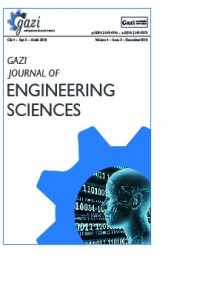Definition of Pneumatic Muscles, Historical Development, Working Principle, Static Modeling, Types, Properties and Application Areas
Abstract
The pneumatic artificial muscle is a kind of actuator composed of a flexible membrane with fittings at both ends. While pneumatic muscles have many advantages over conventional actuators, having a high power / weight ratio is one of the most important of these advantages. As a working principle, with the effect of the gas pressure, in response to the expansion in the radial direction, an axial shortening occurs, so that a pulling force emerges in the axial direction. In this review study, pneumatic muscles were defined and their historical development was mentioned, then the working principle was explained and static equations were tried to be explained. In the following sections, the types of pneumatic muscles are also mentioned, their advantages and disadvantages are also examined. Finally, the use areas of pneumatic artificial muscles are mentioned and examples of application for biorobit, medical, industrial, aerospace and other fields are mentioned and the work done in the result section is summarized
Keywords
References
- Referans1 Daerden, Frank. "Conception and realization of pleated pneumatic artificial muscles and their use as compliant actuation elements." Vrije Universiteit Brussel, Belgium (1999).
- Referans2 Kang, Bong-Soo, et al. "Dynamic modeling of Mckibben pneumatic artificial muscles for antagonistic actuation." Robotics and Automation, 2009. ICRA'09. IEEE International Conference on. IEEE, 2009.
- Referans 3 Mižáková, Jana, Ján Piteľ, and Mária Tóthová. "Pneumatic artificial muscle as actuator in mechatronic system." Applied Mechanics and Materials. Vol. 460. Trans Tech Publications, 2014.
- Referans 4 Daerden, Frank, and Dirk Lefeber. "Pneumatic artificial muscles: actuators for robotics and automation." European journal of mechanical and environmental engineering 47.1 (2002): 11-21.
- Referans 5 Ravina, E. "Mechanical and thermal testing of fluidic muscles." 3rd European Conference on Mechanism Science, Cluj-Napoca, Romania, September. 2010.
- Referans 6 Andrikopoulos, Georgios, Georgios Nikolakopoulos, and Stamatis Manesis. "A survey on applications of pneumatic artificial muscles." Control & Automation (MED), 2011 19th Mediterranean Conference on. IEEE, 2011.
- Referans 7 Chou, Ching-Ping, and Blake Hannaford. "Static and dynamic characteristics of McKibben pneumatic artificial muscles." Robotics and Automation, 1994. Proceedings., 1994 IEEE International Conference on. IEEE, 1994.
Pnömatik Kasların Tanımı, Tarihsel Gelişimi, Çalışma Prensibi, Statik Modellemesi, Çeşitleri, Özellikleri ve Uygulama Alanları
Abstract
Pnömatik kas,
her iki ucunda fitting bulunan esnek bir membran yapısından oluşan bir çeşit
aktüatördür. Pnömatik kasların geleneksel aktüatörlere göre pek çok avantajı
olmakla birlikte, yüksek güç/ağırlık oranına sahip olması bu avantajlardan en
önemlilerinden biridir. Çalışma prensibi olarak gaz basıncının etkisi ile,
radyal yönde meydana gelen genişlemeye karşılık olarak, eksenel yönde kısalma
oluşur ve böylece, eksenel yönde bir çekme kuvveti meydana gelir. Pnömatik
kaslar üzerine yapılan çalışmaların gözden geçirildiği bu çalışmada, pnömatik
kasların tanımı yapılarak, tarihsel gelişiminden bahsedilmiş, daha sonra
çalışma prensibi anlatılmış ve statik denklemleri açıklanmaya çalışılmıştır.
Müteakip bölümlerde çeşitlerine de değinilen pnömatik kasların avantaj ve
dezavantajları da ayrıca incelenmiştir. Son olarak pnömatik kasların kullanım
alanlarından bahsedilmiş ve biorobit, medikal, endüstriyel, havacılık vb.
alanlara yönelik uygulama örnekleri verilerek sonuç bölümünde yapılan çalışma
özetlenmiştir.
Keywords
References
- Referans1 Daerden, Frank. "Conception and realization of pleated pneumatic artificial muscles and their use as compliant actuation elements." Vrije Universiteit Brussel, Belgium (1999).
- Referans2 Kang, Bong-Soo, et al. "Dynamic modeling of Mckibben pneumatic artificial muscles for antagonistic actuation." Robotics and Automation, 2009. ICRA'09. IEEE International Conference on. IEEE, 2009.
- Referans 3 Mižáková, Jana, Ján Piteľ, and Mária Tóthová. "Pneumatic artificial muscle as actuator in mechatronic system." Applied Mechanics and Materials. Vol. 460. Trans Tech Publications, 2014.
- Referans 4 Daerden, Frank, and Dirk Lefeber. "Pneumatic artificial muscles: actuators for robotics and automation." European journal of mechanical and environmental engineering 47.1 (2002): 11-21.
- Referans 5 Ravina, E. "Mechanical and thermal testing of fluidic muscles." 3rd European Conference on Mechanism Science, Cluj-Napoca, Romania, September. 2010.
- Referans 6 Andrikopoulos, Georgios, Georgios Nikolakopoulos, and Stamatis Manesis. "A survey on applications of pneumatic artificial muscles." Control & Automation (MED), 2011 19th Mediterranean Conference on. IEEE, 2011.
- Referans 7 Chou, Ching-Ping, and Blake Hannaford. "Static and dynamic characteristics of McKibben pneumatic artificial muscles." Robotics and Automation, 1994. Proceedings., 1994 IEEE International Conference on. IEEE, 1994.
Details
| Primary Language | Turkish |
|---|---|
| Subjects | Mechanical Engineering |
| Journal Section | Research Articles |
| Authors | |
| Publication Date | December 24, 2018 |
| Submission Date | November 27, 2018 |
| Acceptance Date | December 13, 2018 |
| Published in Issue | Year 2018 Volume: 4 Issue: 3 |



